Container size, shape, construction material, color, and drainage outlets affect the maintenance schedule and ultimately the overall health of cannabis plants.
Containers come in all shapes and sizes and can be constructed of almost anything: plastic, wood, metal, clay, fiber, and more. Cannabis will grow in any clean container that has not been used for petroleum products or deadly chemicals. Fiber and wood containers breathe better than plastic or metal pots. Heavy clay pots are brittle and absorb moisture from the soil inside them, causing the soil to dry out quickly. Metal pots are also impractical for garden rooms because they oxidize (rust) and can bleed off harmful elements and compounds. Wood, although somewhat expensive, is great to construct large raised beds and planters on wheels. Plastic and fiber containers are inexpensive and durable; these offer the best values to indoor gardeners.
Growing in containers allows gardeners to control the water and nutrient regimen of individual plants. Movable potted plants can be turned every few days to let plants receive even lighting for even growth. Huddle small, containerized plants tightly together within the brightest area under the HID lamp. Move containerized plants further apart as they grow. Set small plants on blocks to move them closer to the HID. Weak, problematic, or diseased potted plants can easily be dipped in medicinal solution, quarantined, or culled from the garden.
Containers must be:
- clean,
- have adequate drainage holes, and be
- big enough to accommodate plant growth.
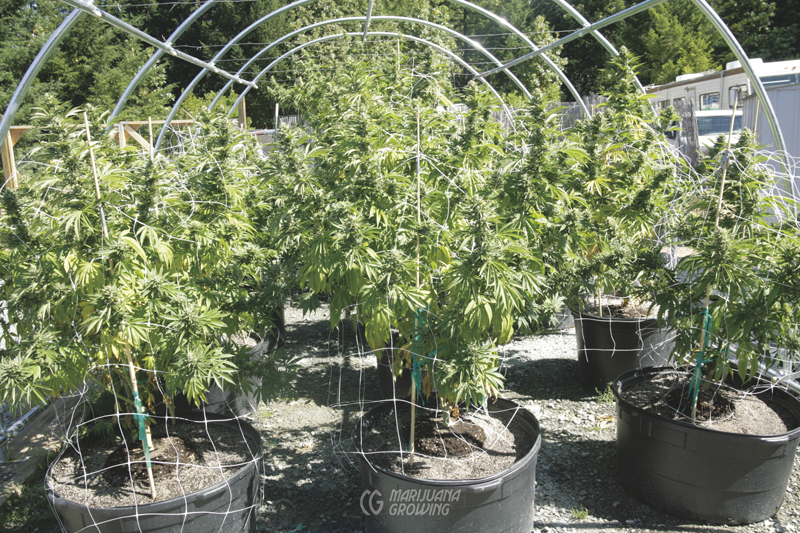
Big containers give roots plenty of room to grow and expand.
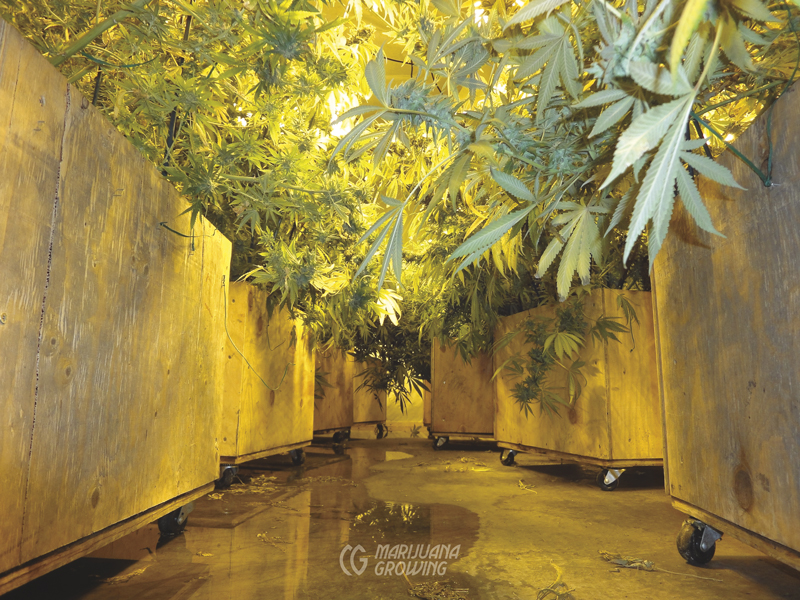
Containers on casters are easy to move, and they stay warmer since they are up off the floor
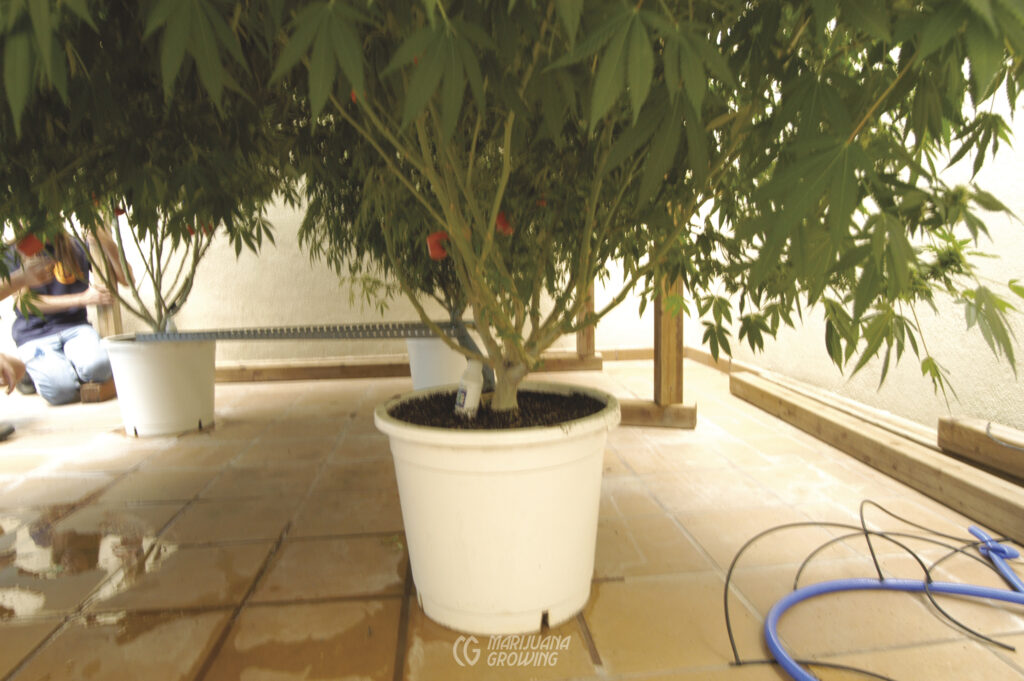
Growing big plants in 5-gallon (19 L) containers is possible but more difficult. Roots use water and nutrients quickly and must therefore be replenished quickly.
Types of Containers
Containers used to cultivate cannabis fall into three basic categories: bags, cans, and beds. Bags consist of containers with a flexible shape such as plastic grow bags and burlap or fiber bags. Cans are a group of containers with rigid sides: plastic pots, large planter boxes, and clay pots. Beds may or may not have rigid sides; the main distinction is that they have no bottom and thus drain freely.
Plastic grow bags are a favorite container among cannabis gardeners. Inexpensive, long-lasting grow bags take up little storage space and are lightweight. A box of 100, 3-gallon (11 L) bags weighs less than 5 pounds (2.3 kg) and measures less than a foot square (30 cm²). One hundred 3-gallon (11 L) grow bags can be stored inside two 3-gallon (11 L) bags. Imagine storing 100 rigid pots in the same space!
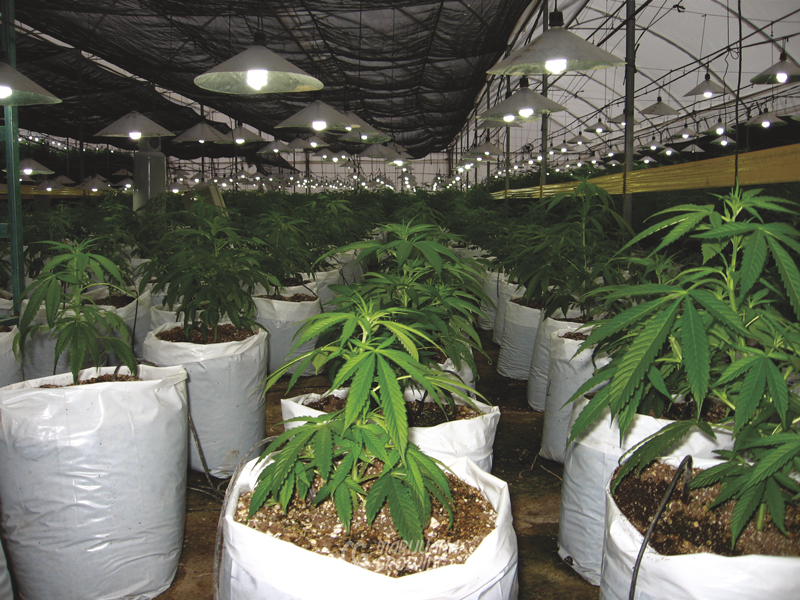
Rigid plastic pots are the most commonly used containers in garden rooms. They are the standard container for nursery stock and are readily available. Most often, they are black with smooth sides and large drainage holes. Black containers absorb heat and reflect very little, causing the root zone to heat rapidly. When allowed to get too hot, roots cook and rot. Once cooked, roots may take a month or more to recover.
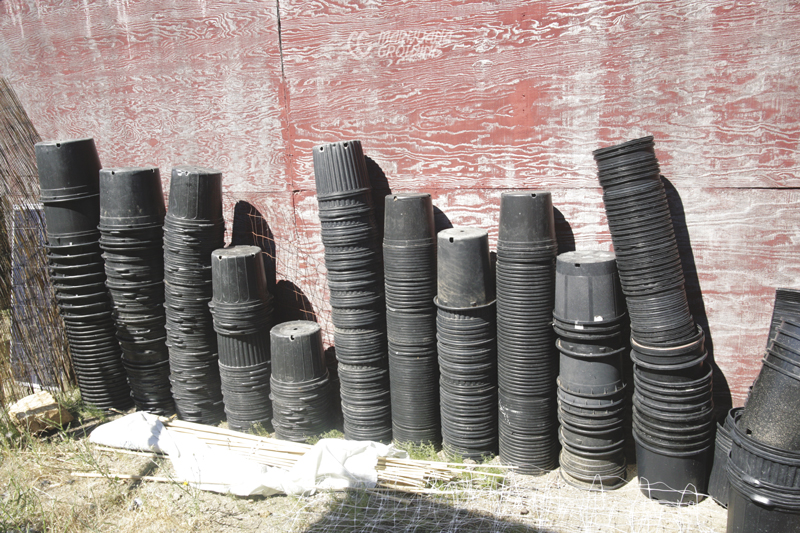
Outdoor garden beds should be at least 6 inches (15 cm) tall to take advantage of a warmer atmosphere aboveground. They can be higher, but little benefit is reaped from extra heat. See chapter 12, Outdoors, for more information on raised beds.
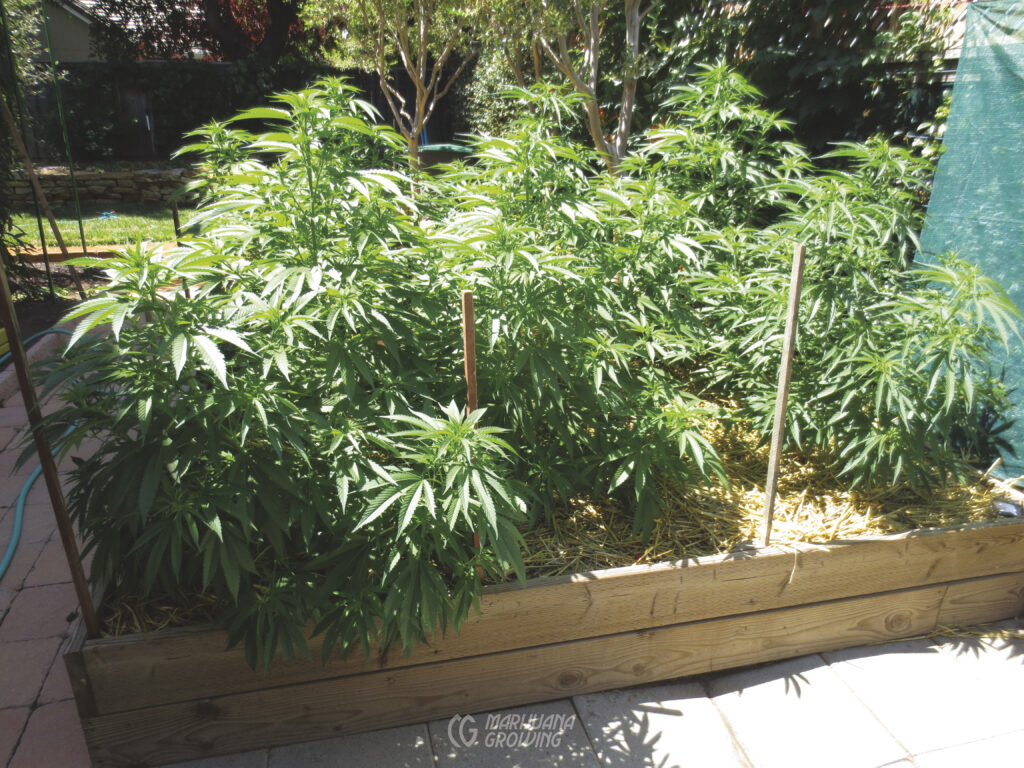
White containers reflect heat and stay cooler, but if placed in full sun, they still get hot enough to cook roots. White containers must be thick or painted a dark color on the inside so that roots receive no light, since light is detrimental to their growth. See ‘Container Problems’ in this chapter.
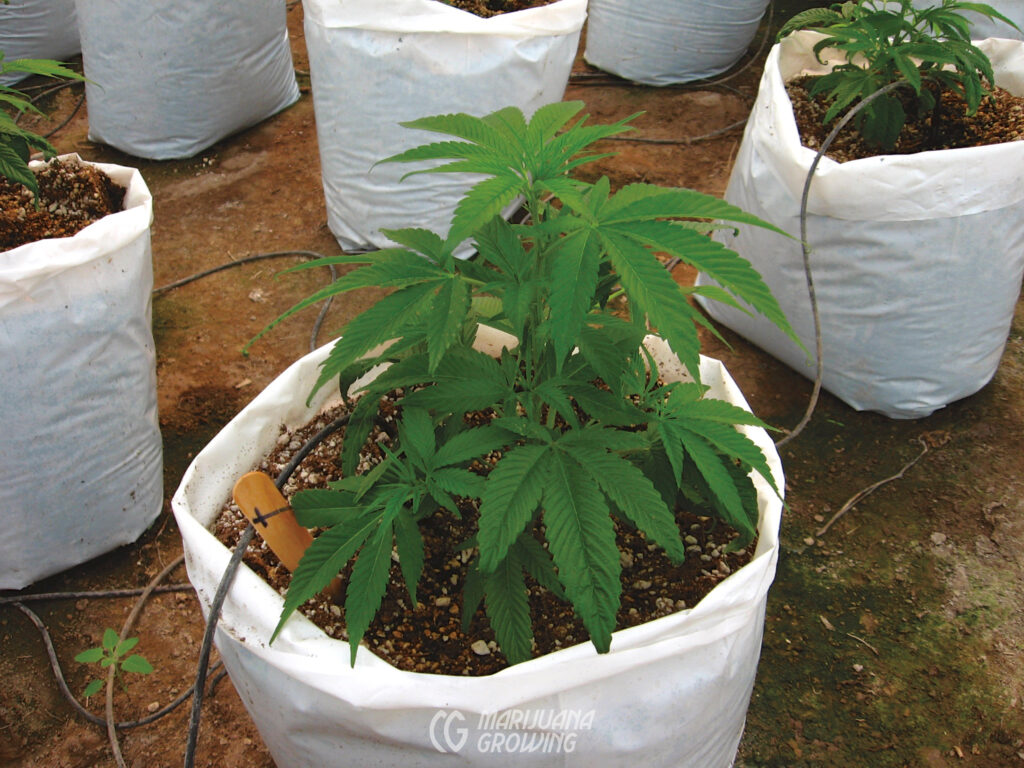
Rigid fiber and paper-pulp pots are popular with gardeners who move their plants outdoors. Removing the container’s bottom eases transplanting into soil. Pot bottoms habitually rot out, but painting the inside of the fiber container with latex paint will keep the bottom from rotting for several crops.
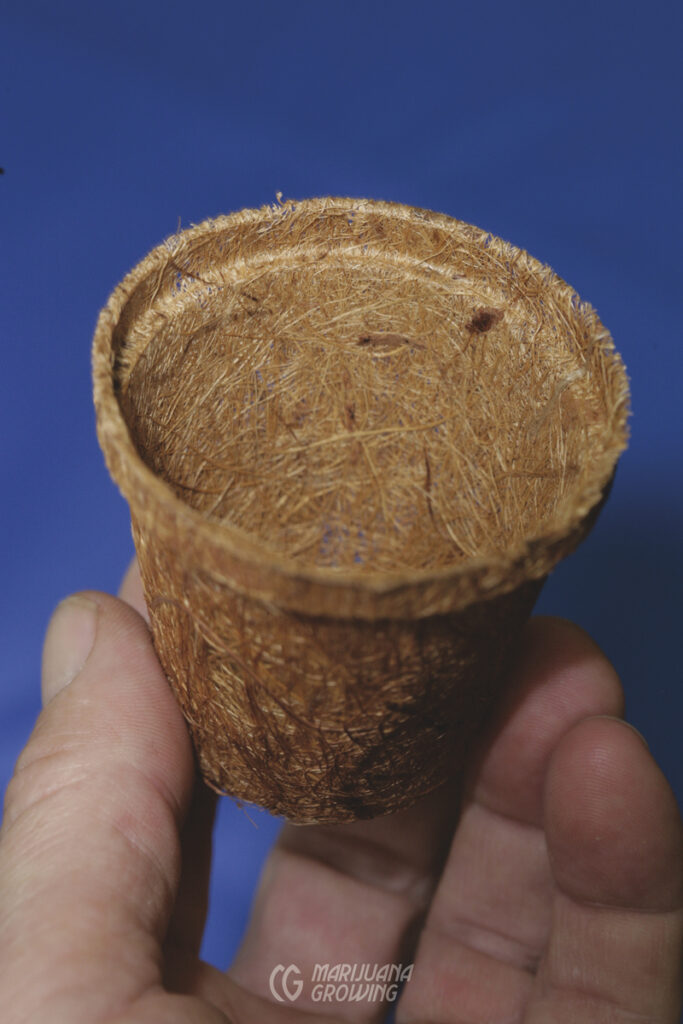
The potting soil sack can be used as a container. The moist soil inside the bag expands and contracts. Keeping soil evenly moist will lessen the chance of burned root tips that grow down the side of bags. Always remember to make adequate drainage holes in bags!
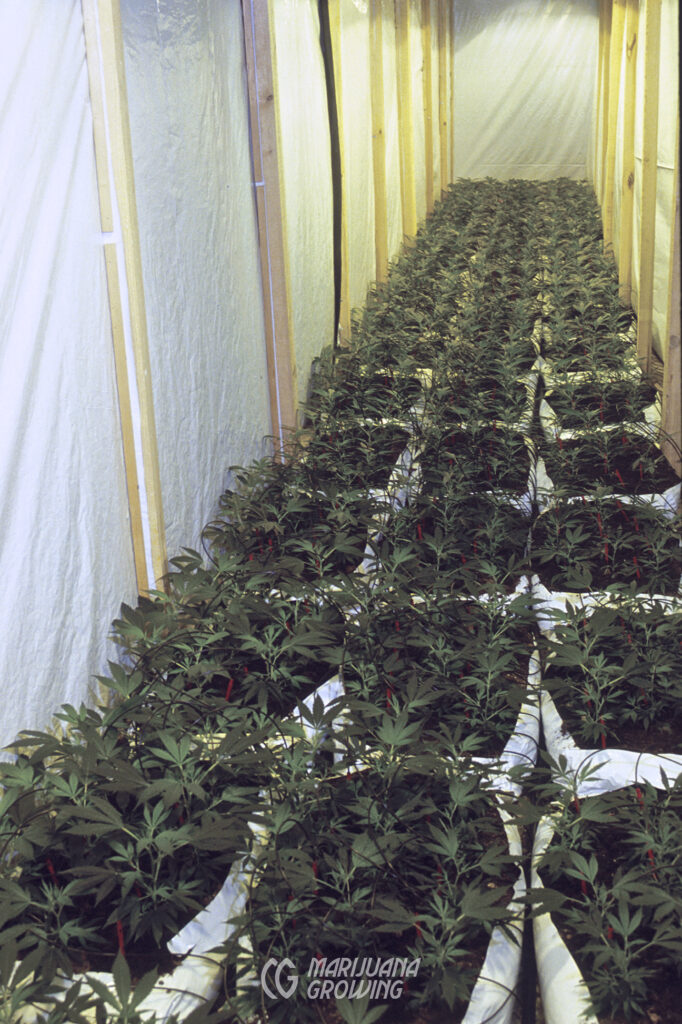
Permeable-fabric grow bags are easy to make with many different types of material. Commercial brands such as Smart Pots, GeoPots, and so forth are gaining in popularity. Grow bags, whether plastic or fabric, are easy to wash and reuse. Empty out the soilless mix and submerge bags in a big container of soapy water overnight. Stir them around with a stick, wash by hand, and hang to dry. Once dry, the bags are ready to reuse. I like fiber pots the best because the air in the sides keeps the roots pruned. For more information, see ‘Root-Pruning Containers’ in this chapter.

Large planter boxes are wonderful. Planters should be as big as possible but still allow easy access to plants. Roots will have more room to grow and less container surface for them to run into and grow down. Set large planter boxes and pots on blocks or casters to allow air circulation underneath. The soil in planter boxes stays warmer, and the plants are more easily maintained.
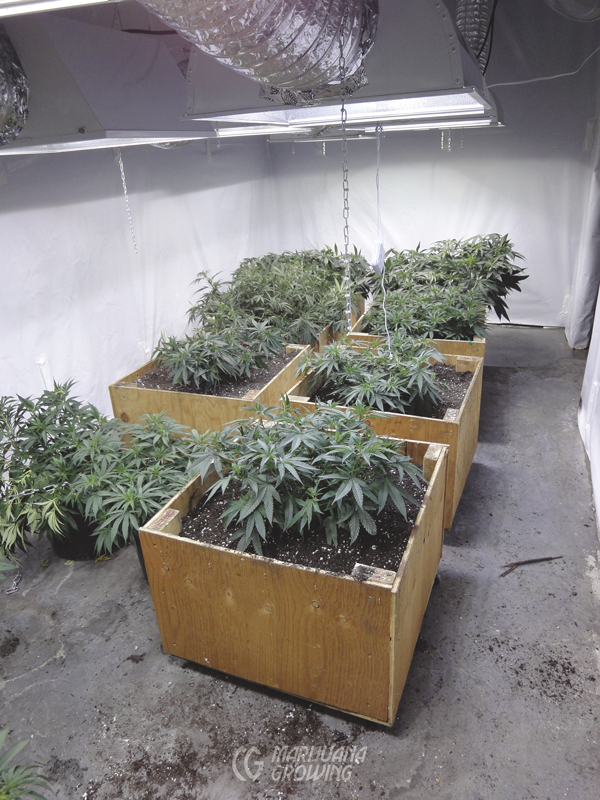
Garden beds are my favorite! Garden beds can be raised with rigid sides or not, but they must be completely open on the bottom and drain directly into Mother Earth. Garden beds can easily be installed on the floor of a greenhouse and outdoors. In fact, I have seen garden beds in basement and outbuilding garden rooms. Please take note, however: the soil below basement garden beds is often poor-quality subsoil that drains poorly.
Container Shape and Size
Popular container shapes include rectangular, square, and cylindrical. Square and rectangular containers can butt up to one another, providing more overall growing medium in gardens. Cylindrical containers are readily available and inexpensive but lack the versatility of square pots.
Containers are wider than deep or deeper than wide. Cannabis gardeners growing indoors and in greenhouses prefer containers that are wider than deep because they are more stable, and surface roots are able to spread out farther. This is true regardless of container size, small or large. Deep containers tip over more easily but promote (seedling) taproot and deep root growth. They are favored to grow small plants that will be transplanted outdoors.
The volume of a container definitely dictates the irrigation and feeding schedule. In most cases, container size helps determine the size of a plant. Cannabis is an annual; it grows very fast and requires a lot of root space for sustained, vigorous development. Containers should allow space for a strong root system but be just big enough to contain the root system before harvest. If the container is too small, roots are confined, and both water and nutrient uptake are limited, which in turn slows growth. But if the container is too big, it requires too much expensive growing medium and becomes heavy and awkward to move.
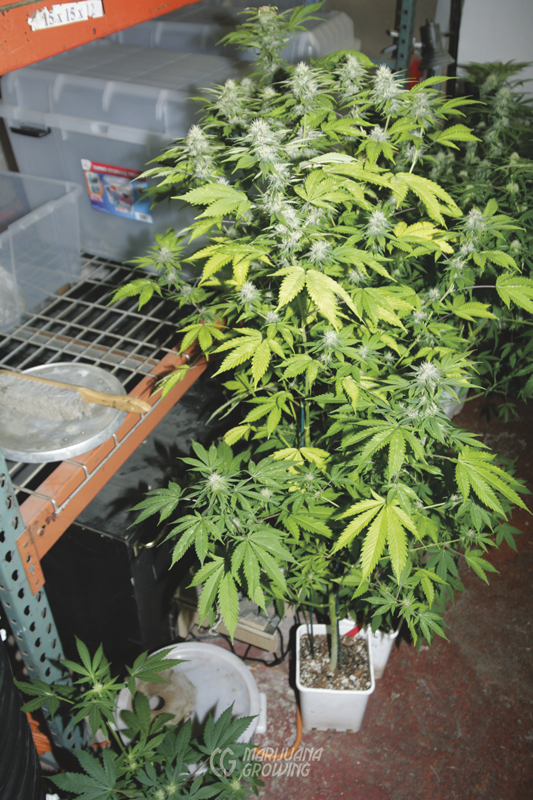
Big plants can grow in small containers but will require several irrigations daily and are likely to have problems.
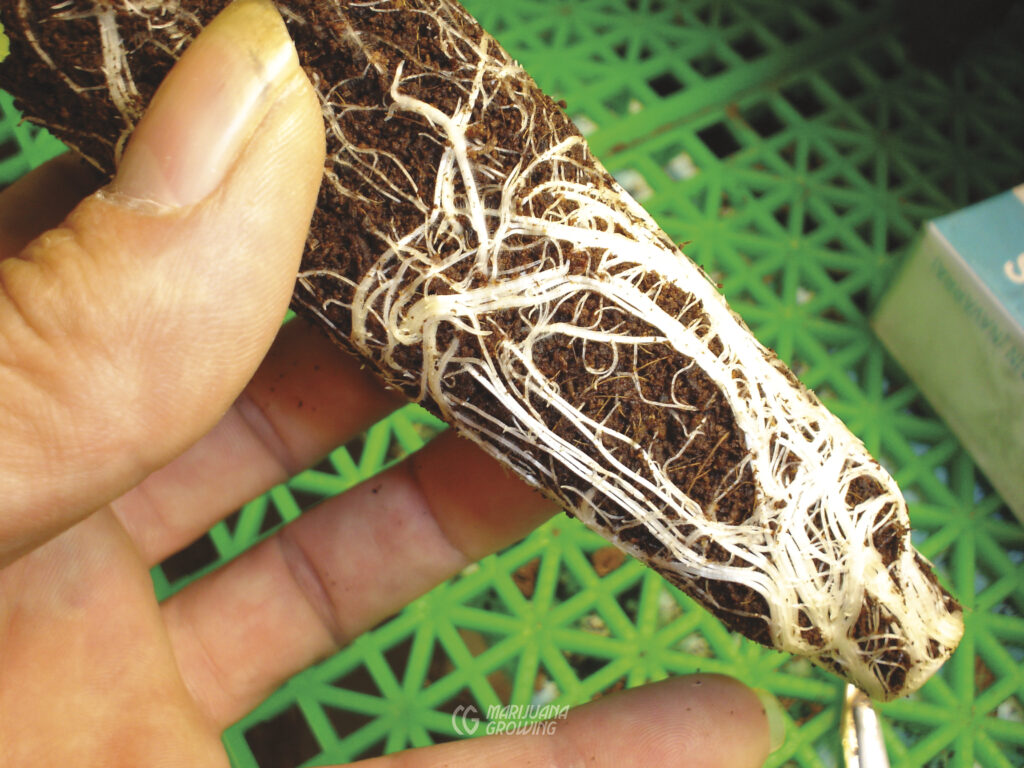
Deep containers are ideal to grow seedlings and clones that will be planted outdoors.

Plants grown in large containers require less-frequent irrigation and are much easier to maintain.
| SELECTING CONTAINERS | ||
| Plant Age | Container Size | Metric Equivalent |
| 0–3 weeks | root cube | root cube |
| 2–6 weeks | 4-inch pot | 10 cm pot |
| 6–8 weeks | 2-gallon pot | 7.5 L pot |
| 2–3 months | 3-gallon pot | 11 L pot |
| 3–8 months | 5-gallon pot | 19 L pot |
| 6–18 months | 10-gallon pot | 38 L pot |
Allow 1 to 1.5 gallons (3.8–5.7 L) of soil or soilless mix for each month that a given plant will spend in its container. A 2- to 3-gallon (7.5–11 L) pot supports a plant for up to 3 months. A 3- to 6-gallon container is good for 3 to 4 months of rapid plant growth.
Small Containers
Three-gallon (11 L) containers are ideal for 2- to 3-foot-tall (60–90 cm) plants. Larger pots are usually unnecessary because plants grow no longer than a week or two in the vegetative stage and 6 to 10 weeks flowering. Smaller 3-gallon (11 L) pots are easy to move and handle. Roots also grow less during
Three-gallon (11 L) containers are ideal for 2- to 3-foot-tall (60–90 cm) plants. Larger pots are usually unnecessary because plants grow no longer than a week or two in the vegetative stage and 6 to 10 weeks flowering. Smaller 3-gallon (11 L) pots are easy to move and handle. Roots also grow less during flowering. By the time a plant is pot-bound, it is ready to harvest. I used to recommend up to a 5-gallon (19 L) container for plants that are harvested after 90 total days of life. I now believe this is a waste. While the smaller containers require daily watering, they produce harvests comparable to those of 5-gallon (19 L) containers.
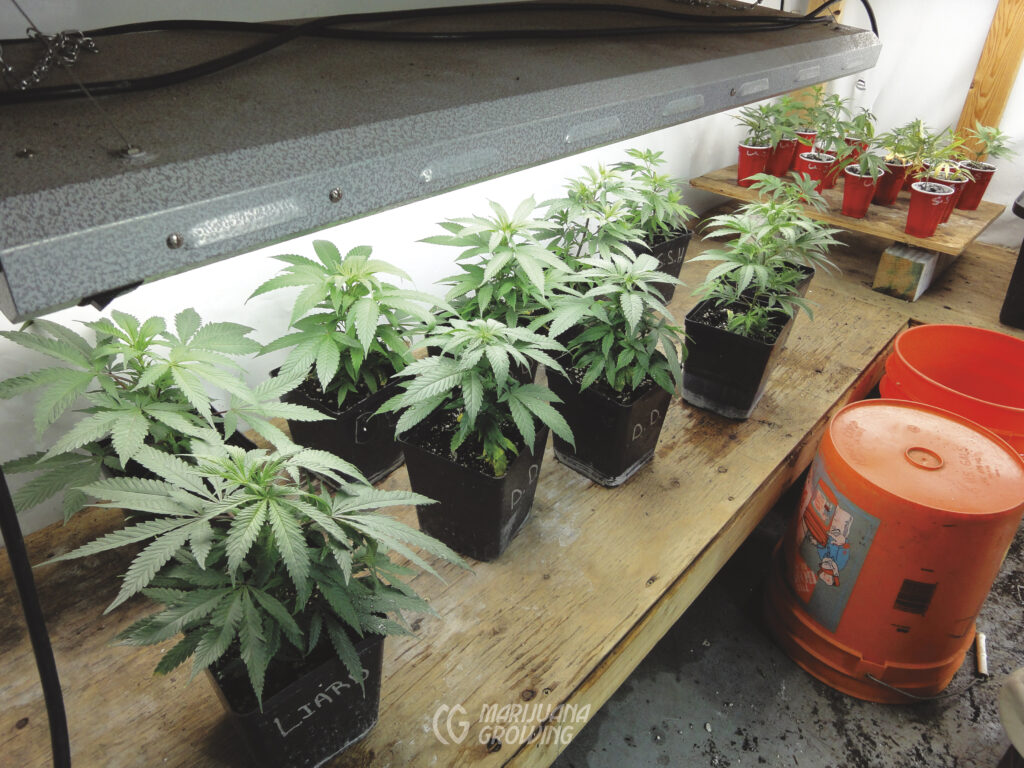
Small containers are great for small plants. They are lightweight and easy to handle. Roots soon outgrow small containers; these clones are ready to transplant.
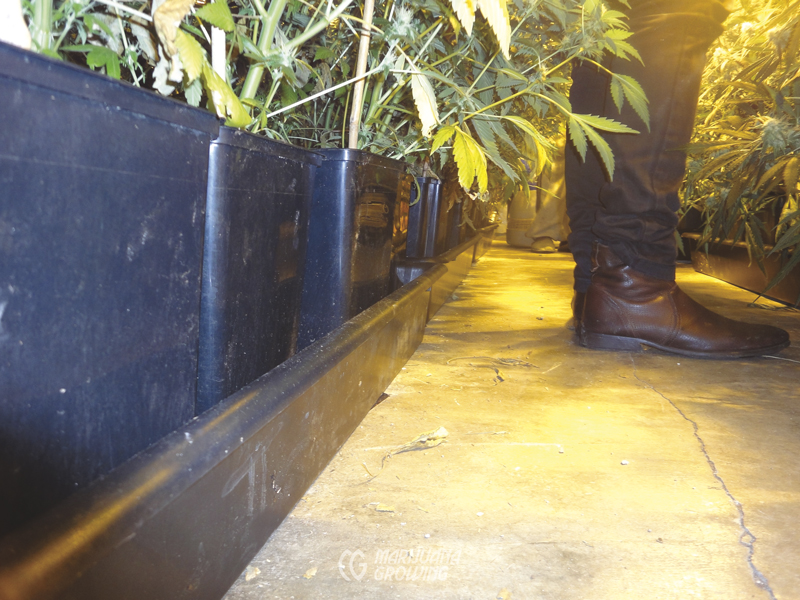
Square containers fit closely together providing more growing medium per square foot (m2).
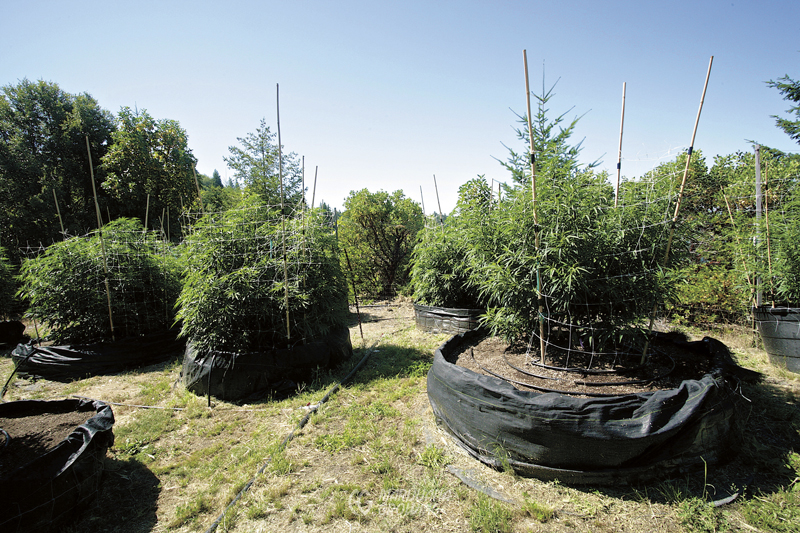
Large containers outdoors sit on top of the ground, forming a barrier to pests that enter through the soil—such as termites, a problem insect in many gardens.
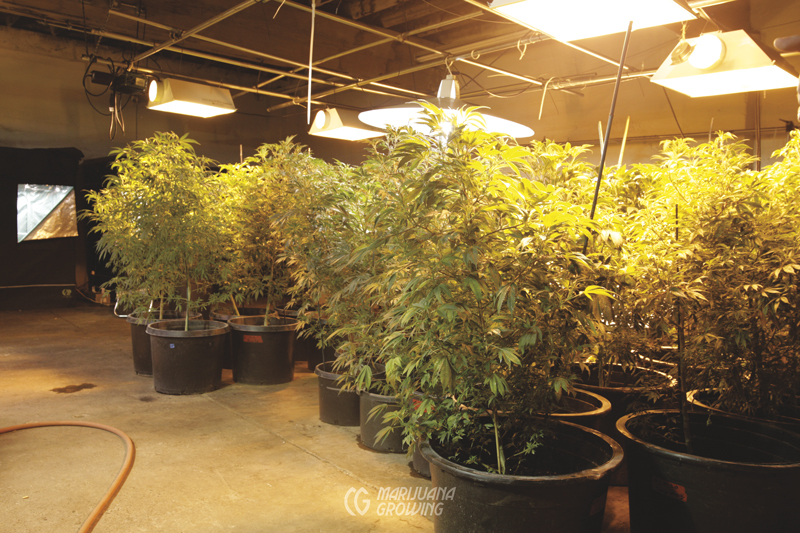
Large containers allow space for root growth as well as biological activity. They are the next best thing to growing in Mother Earth, even indoors.
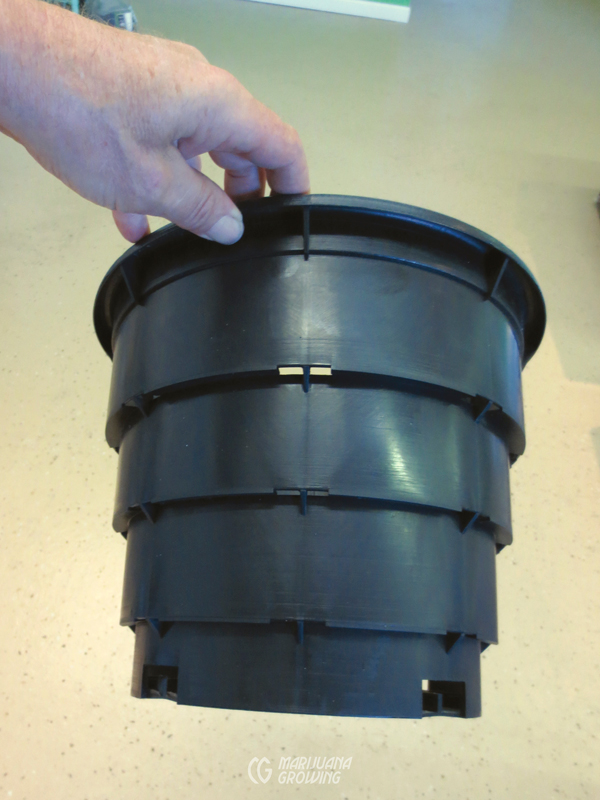
This root-pruning container diverts root growth with different obstacles on the wall. Note that it also has air holes to air prune roots that are encircling the inside of the container.
Large Containers
Mother (stock) plants usually grow larger, longer, and require 5- to 50-gallon (19–190 L) containers when grown in soil. However, mother plants grow quite well in 5- or 10-gallon (19–38 L) hydroponic containers for a year or longer. If you plan to keep a mother plant for more than a few months, grow it hydroponically in its own container for best results.
Root Pruning
Root-Pruning Containers
Root-pruning containers work on a simple principle. Roots tend to grow around and down the inside of containers having a smooth wall. Root-pruning containers place obstacles in the path of roots to divert them and stop or change the direction of root growth.
Air Root-Pruning Containers
Unpruned roots encircle the inside of containers, forming thick masses that are sensitive to temperature changes and will dry out easily. Roots that become dry for long or that cook in hot temperatures will die. Dead roots soon rot, leaving plants vulnerable to diseases, pests, and nutrient deficiencies.
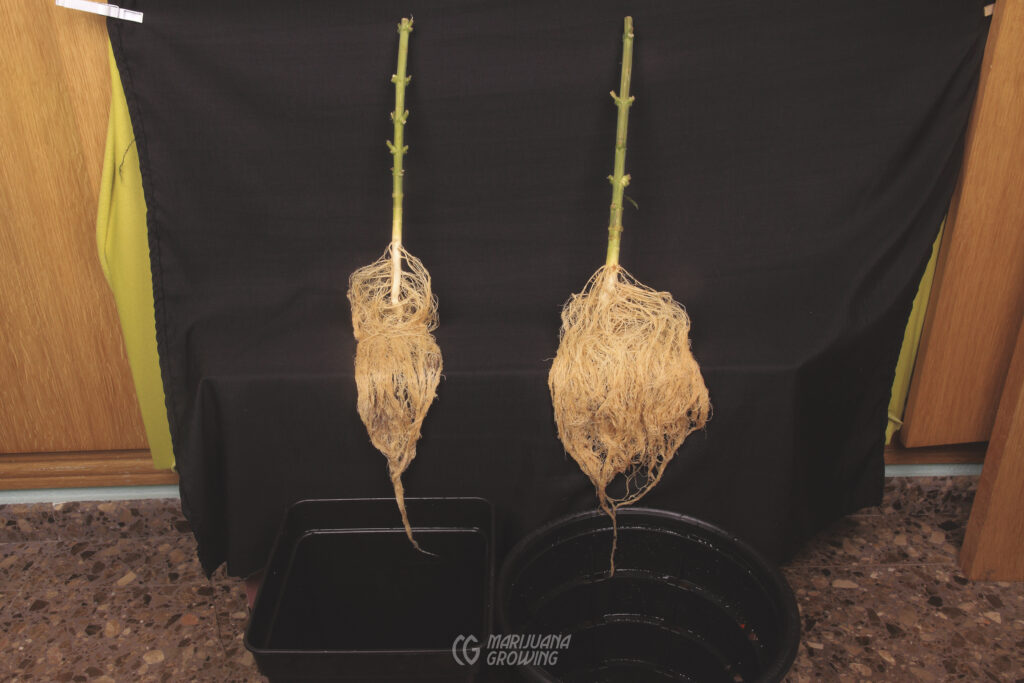
The roots on the left were grown in a smooth- sided 3-gallon (11 L) container. The root mass on the right was grown in the 3-gallon (11 L) root-pruning container above.
When roots grow to the end of a container with permeable sides and are exposed to air, the root tips stop growing. More feeder roots form along the main stem of the root. Air naturally prunes the tips of roots, and the roots form a dense mass inside the container. Gardeners can make their own permeable air-pruning containers from many different materials, or such containers can be purchased from retail or wholesale outlets.
Clone and seedling roots are easy to air prune. Holes in air-pruning flats are shaped like a cone with a hole at the bottom. Roots are directed down the container and out the hole in its bottom. The tips of the roots dry out once they come into contact with air, thus pruning them. Use these containers if you must hold clones for a week or longer than you desire.

Uneven surfaces allow for more root growth, and a series of holes permits air to prune roots.
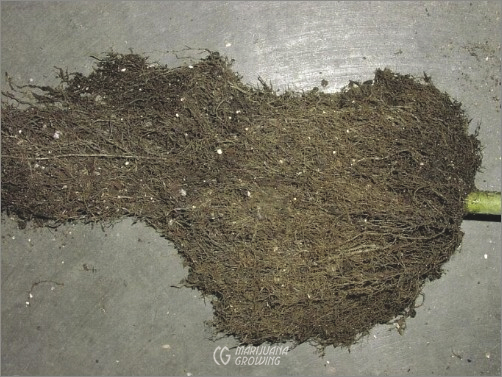
This dense mass of roots is the result of chemical root pruning. The same result can be achieved by using air-pruning containers.
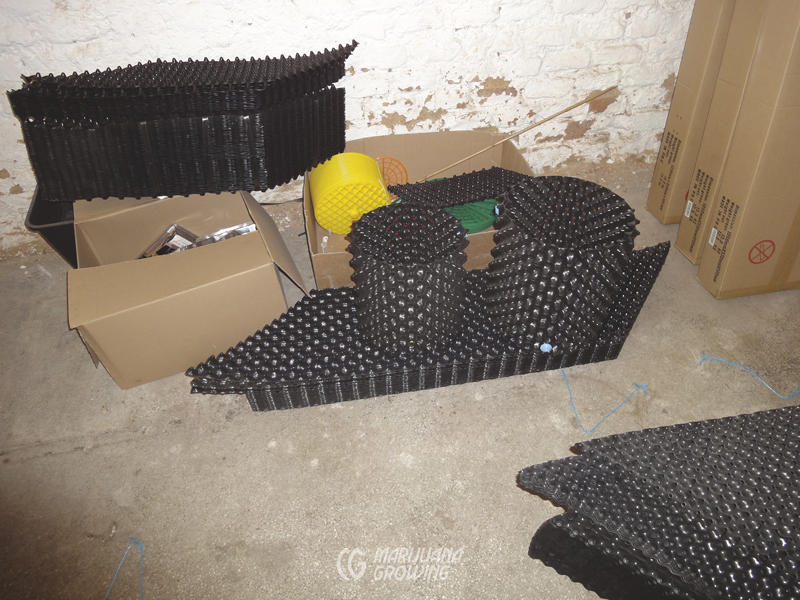
These air-pruning containers require little storage space and are easy to assemble.
Chemical Root Pruning
Chemical root pruning controls root growth inside containers. Commercial nurseries have been using chemical root pruning for many years with outstanding results. Uncle Ben, a charter member of the defunct site www.overgrow.com tuned us in to chemical root pruning, and we thank him!
Uncle Ben used a product called SePRO Griffin’s Spin-Out that consists of copper hydroxide suspended in water-soluble paint as a carrier. To use, simply brush-paint container insides with two coats of the product. Roots grow to within a fraction of an inch of the copper hydroxide, and then stop. Roots will not touch the copper compound. The result is essentially the same as is achieved with air pruning. Plants having a dense root system dispersed evenly throughout the root ball are easier to maintain, and they grow bigger in smaller containers.
Note: Medical cannabis gardeners avoid using copper compounds to prune roots, citing root burn problems. In elemental form, copper is easy to overapply, and it quickly becomes toxic to plants. Copper sulfate (0.3%) is less toxic than copper hydroxide. Both compounds are insoluble in water, and ions do not translocate to roots.
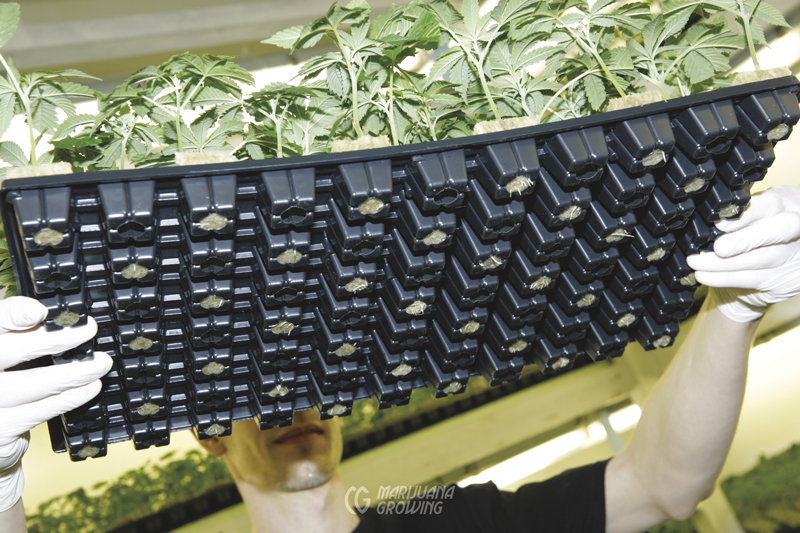
Roots on these clones grow through drainage holes. Once they hit the air, growth stops. Roots are thus “air pruned.”
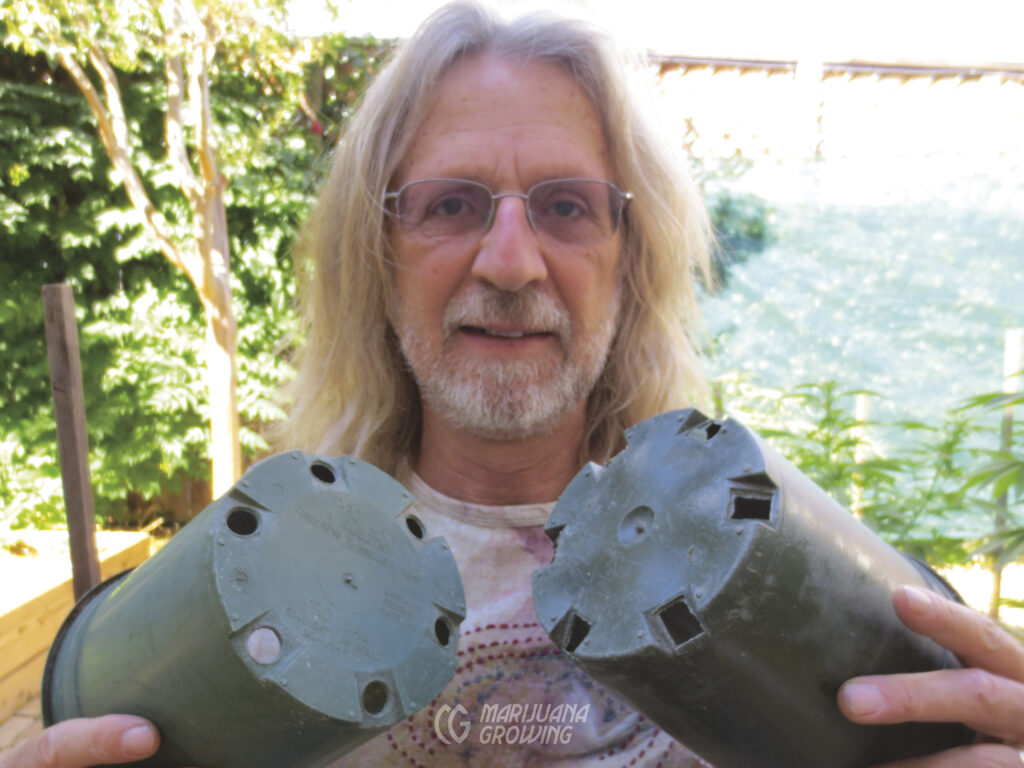
Drainage holes are essential in all containers. I prefer the container on the right with larger holes that run slightly up the sides to the one on the left with smaller holes on the bottom only.
Physical Root Pruning
Physically pruning roots may be necessary to give new life to potbound plants outdoors or in greenhouses. Removing roots will not make plants grow faster; in fact, it will slow growth for about two weeks. Once new roots start to grow, however, growth rebounds. About midsummer, root pruning can help plants that must stay in the same size container. Root pruning will keep plants manageable and much easier to maintain. Physical root pruning is the last option; try air pruning and chemical root pruning first.
Drainage and Leaching
All containers need some form of drainage. Drainage holes allow excess water and nutrient solution to flow freely out the bottom of a container. Drainage holes should let water drain easily but not be so big that growing medium washes out. Containers should have at least two.
All containers need some form of drainage. Drainage holes allow excess water and nutrient solution to flow freely out the bottom of a container. Drainage holes should let water drain easily but not be so big that growing medium washes out. Containers should have at least two half-inch (1.2 cm) holes per square foot (929 cm²) of the bottom. Most pots have twice this amount. To slow drainage and keep soil from washing out of the large holes, add a 1-inch (2.5 cm) layer of gravel in the bottom of the pot.
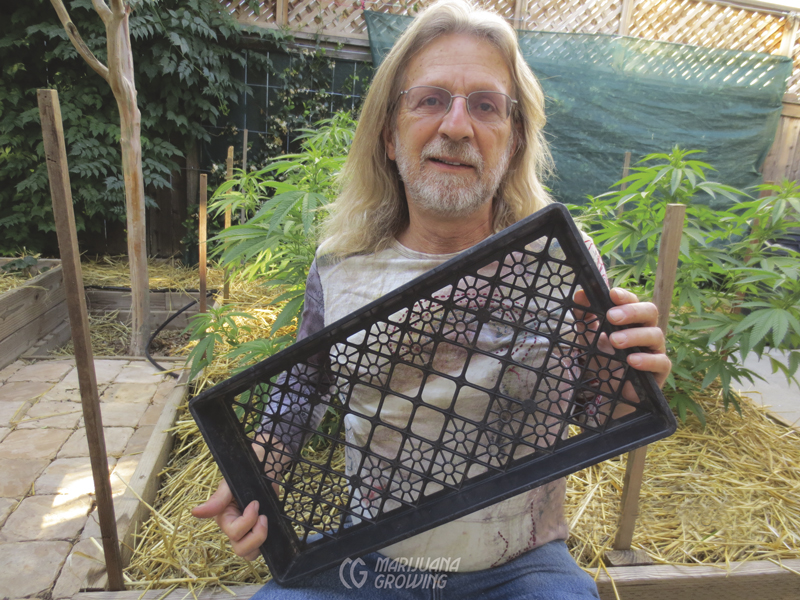
This nursery tray is used to hold small con- tainers. It provides extra space below so that containers drain and do not sit in water.
Surface tension created by the varying sizes of soil and rock particles, and a lot of other interesting science, causes water to be retained at the bottom of the container. Line pots with newspaper if drainage is too fast or if soil washes out of drainage holes, but be wary of overly slowing the drainage.
Put trays under containers to catch excess water. Do not let water stand in saucers for more than 20 minutes or waterlogged roots will die and rot. Set containers up on blocks so water drains into saucers or trays and roots do not sit in water. Nursery trays used for rooting cuttings and growing seedlings must have good drainage throughout the entire bottom. Once clones and seedlings are in place in the tray, the tray should always drain freely with no standing water in the bottom.
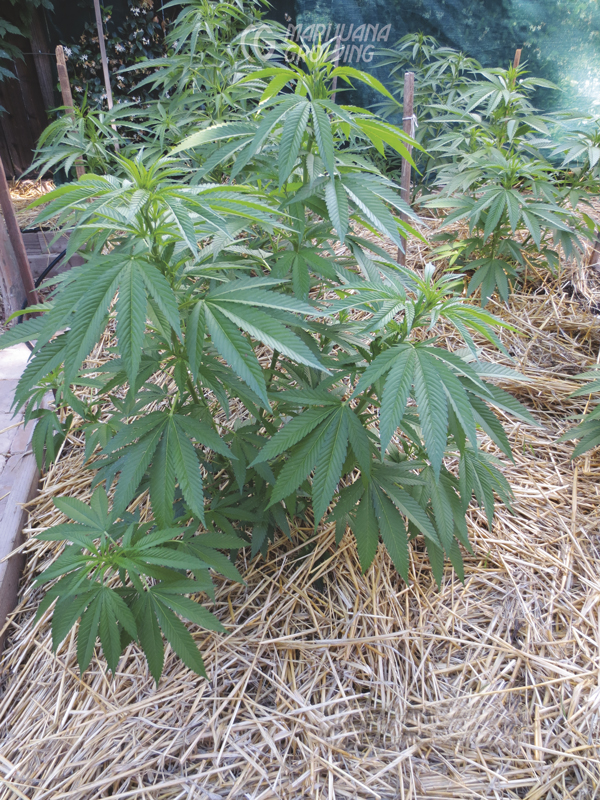
Feeder roots grow near the soil surface, just under the mulch. I like to add mulch to out- door, indoor, and greenhouse containers.
Container Problems
Do not place containers in direct heat. If soil temperature in pots climbs beyond 75°F (24°C), it can damage roots. Shade pots that are in direct sun with a piece of plastic or cardboard to keep the soil temperature below 75°F (24°C).
A 1 to 2-inch (2.5–5 cm) layer of hydroclay mulch on the soil surface keeps the soil surface moist. Roots are able to grow along the surface, and the soil does not need to be cultivated. The hydroclay mulch also decreases evaporation and helps keep irrigation water from damaging roots or splashing out of containers.
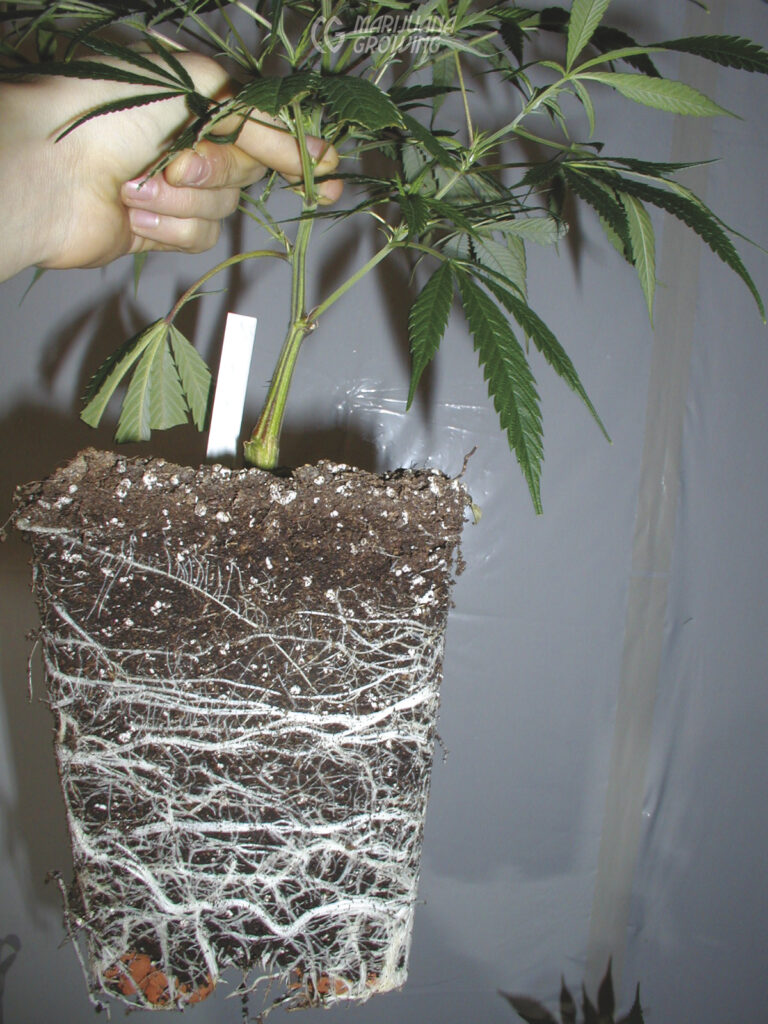
This rootbound plant appears healthy above- ground but will stop growing as soon as roots suffer heat or moisture stress.
Roots soon hit the sides of containers, grow in circles, and later grow down and mat up around the bottom. The unnatural environment inside the container often causes a thick layer of roots to grow alongside the container walls and bottom. This portion of the root zone is the most vulnerable to moisture and heat stress and is the most exposed to it. Often inexperienced or lazy gardeners set such plants in a saucer to contain irrigation water. The submerged roots soon die and rot, compounding the problems.
Avoid such problems by transplanting plants before they become rootbound or by using root-pruning containers.
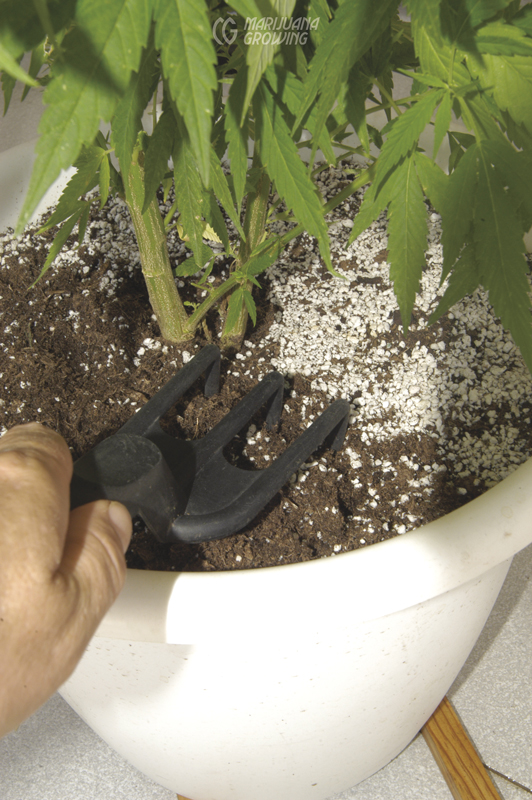
Lightly cultivate the soil surface so water penetrates evenly. Be careful to avoid disturb- ing the roots.
When soil dries in a pot, it becomes smaller, contracting and separating from the inside of the container wall. This condition is worst in smooth plastic pots. When this crack develops, frail root hairs located in the gap quickly die when they are exposed to air whistling down this crevice. Water also runs straight down this crack and onto the floor. You may think the pot was watered, but the root ball remains dry. Avoid such killer cracks by cultivating the soil surface and running your finger around the inside lip of the pots. Lightly cultivate the surface of the soil every few days and maintain evenly moist soil to help keep root hairs on the soil perimeter from drying out. A layer of mulch will also help avoid the gap between soil and container.
White containers reflect light and keep soil cooler. Always use thick, white containers so light does not penetrate and subsequently slow root growth. If roots around the outside of the root ball start turning green, you know they are receiving direct light. Remedy the problem by painting the inside of the container with a nontoxic latex paint.
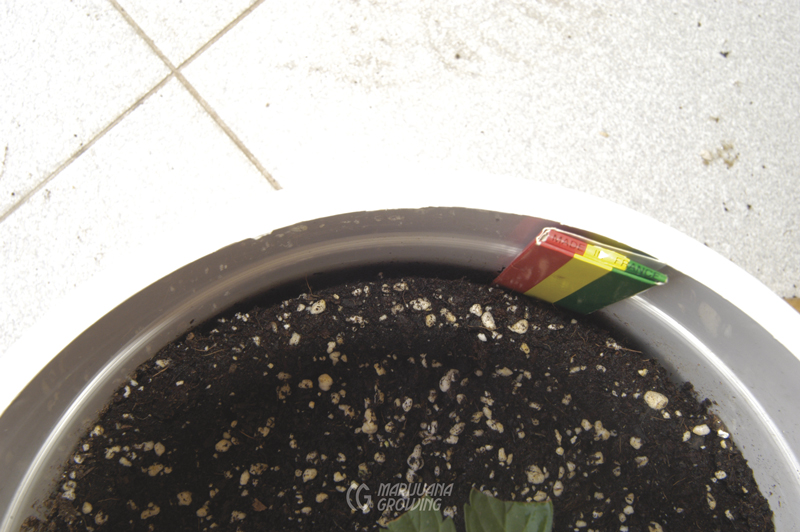
Soil shrinks when dry; it causes a gap to form alongside the container’s inside wall.
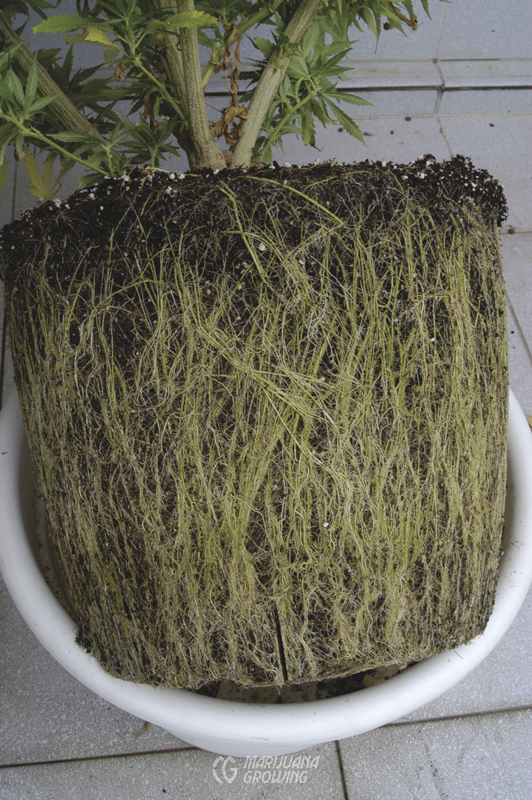
Low levels of sunlight through container walls cause unhealthy green roots. Paint containers black inside to cut light transmission.

